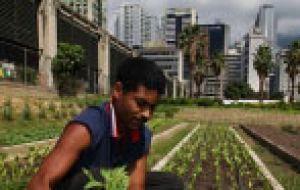MercoPress. South Atlantic News Agency
Central Chile has lost 38% of forests between 1975 and 2008
 The loss has been to agriculture and urban growth
The loss has been to agriculture and urban growth A study of satellite images released this week confirmed a 38% decrease in Chile’s Central Valley forest cover between 1975 and 2008. Forests that used to grow between the coast and the central valley have been replaced either by urban growth or agricultural activity. In some cases the forests have become arid lands.
The satellite image report was provided by the ReForlan project - a group funded by the European Union which seeks to identify dry land ecosystems and implement sustainable management practices for them.
The study was carried out with the Universidad de Concepción, the Universidad Católica and the Universidad Austral and covers an area of 1,300,000 hectares, including 32 communities.
“The study revealed that the forests are declining by 1.4% each year,” said Cristián Echeverría, a Forestry Sciences professor at Universidad de Concepción.
The report confirms that deforestation leads to land erosion. In the Navidad (Region VI) and Concón (Region V) communities, 19% of the area that used to be forested are now bare and eroded lands.
The study identified Viña del Mar, Peñaflor, Casablanca and Alhué as the most affected communities in terms of social and ecological damages. “The project doesn’t just promote re-forestation, it also seeks to help us relearn ecological processes,” said Echeverría. “This is a lot more complex, since it seeks to bring vegetation back to previous levels.”
In 1975 native forests were most abundant in the Metropolitan Region town of Alhué (35%), the Region VI town Doñihue (31%) and the Region V towns of Olmué (30%) and Quilpué (29%). Thirty-five years later, these forests have been reduced between 50 and 75% in some communities.
Still, the news isn’t completely bleak. Despite the deforestation, Alhué has undergone a number of sustainability building initiatives. Between September 2005 and December 2006, Chilean NGO Casa de la Paz set up the Alhué Sustainable Town project with a US$ 50,000 grant from the United Nations Development Program (UNDP).
The project was also supported with US$20,000 from Chile’s National Copper Corporation (CODELCO), whose tailings dam leaked in 2006, polluting surrounding wetlands.
As a result, there have been a number of clean-ups, compost area established and tree planting initiatives. These efforts have been supported by Casa de la Paz, the National Commission on the Environment (CONAMA), the National Forest Corporation (CONAF) and the Minera Florida company- a gold mine accused by local communities in the Altos de la Cantillana area of polluting the air with dust.
By Gida Homad-Hamam - Santiago Times




Top Comments
Disclaimer & comment rulesCommenting for this story is now closed.
If you have a Facebook account, become a fan and comment on our Facebook Page!